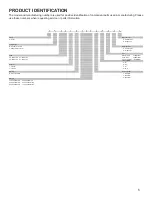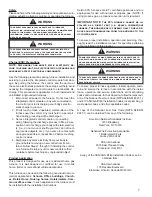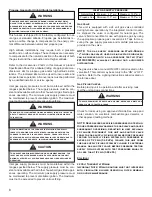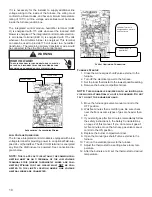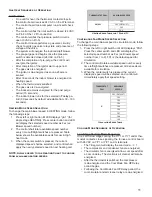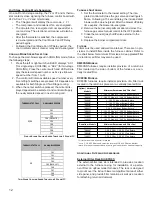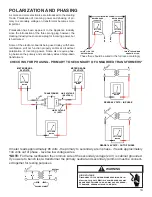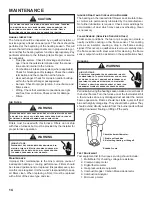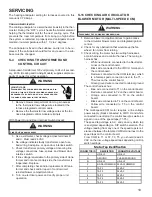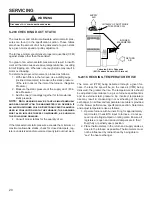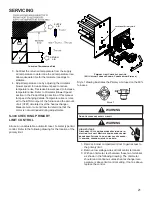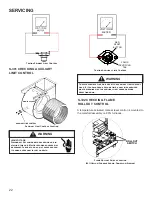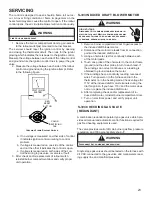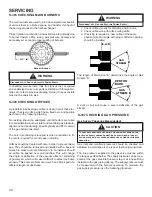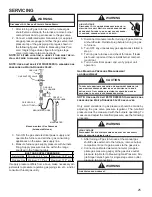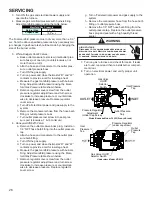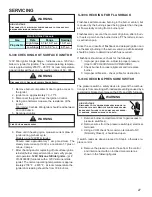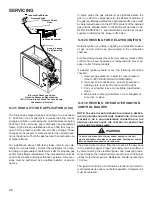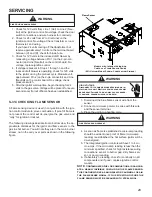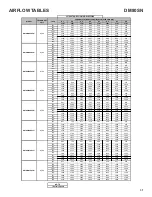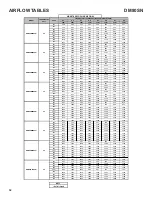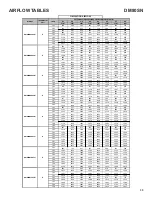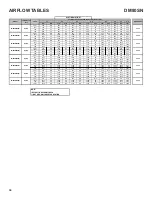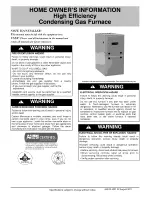
19
SERVICING
The heating anticipator setting for furnaces covered in this
manual is 0.70 Amps.
Cooling Anticipator
The cooling anticipator is a small heater (resistor) in the ther-
mostat. During the “OFF” cycle it heats the bimetal element
helping the thermostat call for the next cooling cycle. This
prevents the room temperature from rising too high before
the system is restarted. A properly sized anticipator should
maintain room temperature within 1 1/2 to 2 degrees.
The anticipator is fixed in the subbase and is not to be re
-
placed. If the anticipator should fail for any reason, the sub
-
base must be changed.
S-4 CHECKING TRANSFORMER AND
CONTROL CIRCUIT
A step-down transformer 120 volt primary to 24 volt second
-
ary, 40 VA (Heating and Cooling Models) supplies ample ca
-
pacity of power for either operation.
WARNING
HIGH VOLTAGE
Disconnect ALL power before servicing or in
-
stalling this unit. Multiple power sources may
be present. Failure to do so may cause proper
-
ty damage, personal injury or death.
1. Remove blower compartment door to gain access
to the thermostat low voltage wires located at the
furnace integrated control module.
2.
Remove the thermostat low voltage wires at the fur
-
nace integrated control module terminals.
With Power On (and Door Interlock Switch closed):
WARNING
Line Voltage now present.
3.
Use a voltmeter, check voltage across terminals R
and C. Must read 24 VAC.
4.
No voltage indicates faulty transformer, open fuse,
bad wiring, bad splice, or open door interlock switch.
5.
Check transformer primary voltage at incoming line
voltage connections, fuse, splices, and blower door
interlock switch.
6.
If line voltage is available to the primary side of trans
-
former and not at secondary side, the transformer is
inoperative. Replace.
7.
After completing check and/or replacement of trans
-
former and check and/or repair of control circuit,
reinstall blower compartment door.
8.
Turn on electrical power and verify proper unit
operation.
S-16 CHECKING AIR CIRCULATOR
BLOWER MOTOR (MULTI-SPEED ECM)
WARNING
Disconnect ALL power before servicing.
1. Remove blower compartment door to gain access
to the circulator blower motor and integrated ignition
control.
2.
Check for any obstruction that would keep the fan
wheel / fan motor from turning.
3.
Check wiring, the motor has two wiring harnesses,
a main harness and a control harness. The main pin
harness has:
•
White neutral wire connected to the Neutral ter-
minal on the control board.
•
Black wire connected to the CIRC H terminal on
the control board.
•
Red wire connected to the COM terminal, which
is a female spade connection next to the T1 –
T5 wires on the control board.
•
Green ground wire connected to cabinet ground
The control harness has:
•
Blue wire connected to T1 on the control board.
•
Red wire connected to T2 on the control board.
•
Orange wire connected to T3 on the control
board.
•
Black wire connected to T4 on the control board.
•
Yellow wire connected to T5 on the control
board.
The multi-speed ECM motor requires a line voltage
power supply (black connected to CIRC H and white
connected to neutral on the control board) as well as a
signal on one of the speed taps (T1-T5).
The speed tap voltage is A.C. and can vary which tap
is energized depending on DIP switch selection. The
voltage reading from any one of the speed taps is ref
-
erenced between the female COM terminal next to the
speed taps on the control board.
From COM to T1 or T2, T3, T5, you should read 24
VAC on the low voltage speed taps depending on Dip
switch settings.
CONNECTOR ID
DESCRIPTION
CONNECTOR VOLTAGE
L
LINE, L1
LINE, L1
G
GROUND
CHASSIS GROUND
N
LINE, L2
LINE, L2
C
SIGNAL COMMON 24VAC COMMON
1
TAP 1
24VAC
2
TAP 2
24VAC
3
TAP 3
24VAC
4
TAP 4
24VAC
5
TAP 5
24VAC
Motor Tap Iden
�fi
ca
�
on

